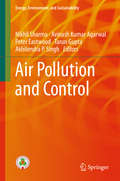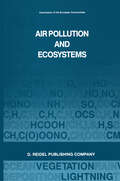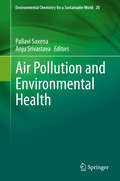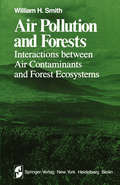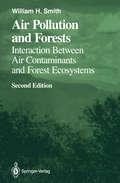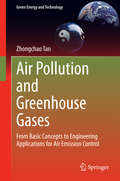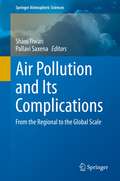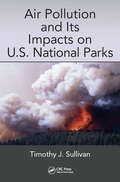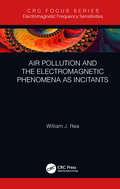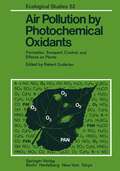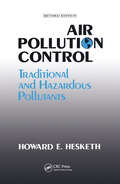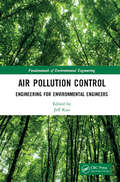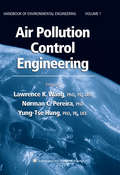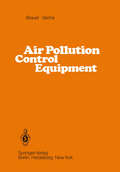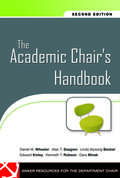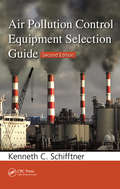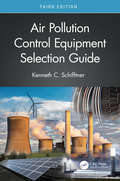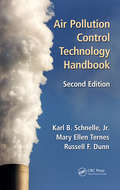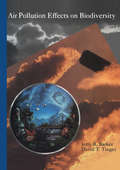- Table View
- List View
Air Pollution and Control (Energy, Environment, and Sustainability)
by Nikhil Sharma Avinash Kumar Agarwal Peter Eastwood Tarun Gupta Akhilendra P SinghThis book focuses on various aspects related to air pollution, including major sources of air pollution, measurement techniques, modeling studies and solution approaches to control. The book also presents case studies on measuring air pollution in major urban areas, such as Delhi, India. The book examines vehicles as a source of air pollution and addresses the quantitative analysis of engine exhaust emissions. Subsequent chapters discuss particulate matter from engines and coal-fired power plants as a major pollutant, as well as emission control techniques using various after treatment systems. The book’s final chapter considers future perspectives and a way forward for sustainable development. It also discusses several emission control techniques that will gain relevance in the future, when stricter emission norms will be enforced for international combustion (IC) engines as well as power plants. Given its breadth of coverage, the book will benefit a wide variety of readers, including researchers, professionals, and policymakers.
Air Pollution and Ecosystems: Proceedings of an International Symposium held in Grenoble, France, 18–22 May 1987
by P. MathyIn the concluding session of the symposium "Acid Deposition, a Challenge for Europe" held in Karlsruhe in September 1983, Dr. GINJAAR, the former Minister of Health and Environmental Protection of the Netherlands, emphasised the need for setting up a concerted research programme including the effects of air pollution on terrestrial and aquatic ecosystems. The Council of Ministers of the European Community in 1984 adopted a revision of the 3rd Community Programme on Environment comprising contract research and concerted action in the field of the effects of air pollution in eco systems. These research areas were also introduced in the 4th R-D Community Programme on Environment, adopted by the Council of Ministers in 1986 and are subject again to contract research and concerted action. The Commission of the European Community is very concerned to increase the effectiveness of researcn projects carried out within the national programmes, and those undertaken at the Community level. The Commission tends to develop an integrated scientific approach, including not only the physico-chemical behaviour, the transport and the deposition of airborne pollutants but also the effects of these pollutants, in particular on living organisms and ecosystems. With regard to the specific issue of the effects, the Commission is trying to develop and strengthen a multi-disciplinary approach associating biologists, pathologists, eco physiologists, and specialists of soil sciences, within the concerted action, as well as within coordinated research projects.
Air Pollution and Environmental Health (Environmental Chemistry for a Sustainable World #20)
by Pallavi Saxena Anju SrivastavaAir pollution is an alarming problem, not only in terms of air quality, but also in relation to health issues. Toxic air pollutant concentrations produce harmful impacts on plant health and human health. Further, though there are various sources of air pollution, anthropogenic and biogenic sources are becoming increasingly problematic. A number of control methods have been applied to reduce the air pollutant concentrations so that their global environmental burden on plants as well as humans can be mitigated. However, as confirmed in numerous reports and studies, their concentrations continue to be very high and everyday cases related to air pollution have become exponentially high not only in developing countries but also in developed countries. In plants, toxic air quality has various adverse effects, including biochemical and physiological disorders, chronic diseases and/or lower yields. In humans, air pollutants affect the body’s metabolism and immune system, lungs and central nervous system. This book provides an essential overview of air pollution, its impacts on plant and human health, and potential control strategies. The respective chapters cover general monitoring and characterization techniques for air pollutants, air quality modelling applications, plant and human health effects, risk assessment, and air pollution control policy. Given its scope, the book offers a valuable and unique resource for students of Environmental Science, Biological Science, Medical Science and Agriculture; and for environmental consultants, researchers and other professionals whose work involves air quality, plant and human related research.
Air Pollution and Forests: Interactions Between Air Contaminants and Forest Ecosystems (Springer Series on Environmental Management)
by William H. SmithThis series is dedicated to serving the growing community of scholars and practitioners concerned with the principles and applications of environmental management. Each volume will be a thorough treatment of a specific topic of importance for proper management practices. A fundamental objective of these books is to help the reader discern and implement man's stewardship of our environment and the world's renewable resources. For we must strive to under stand the relationship between man and nature, act to bring harmony to it, and nurture an environment that is both stable and productive. These objectives have often eluded us because the pursuit of other individual and societal goals has diverted us from a course of living in balance with the environment. At times, therefore, the environmental manager may have to exert restrictive control, which is usually best applied to man, not nature. Attempts to alter or harness nature have often failed or backfired, as exemplified by the results of imprudent use of herbicides, fertilizers, water, and other agents. Each book in this series will shed light on the fundamental and applied aspects of environmental management. It is hoped that each will help solve a practical and serious environmental problem.
Air Pollution and Forests: Interactions between Air Contaminants and Forest Ecosystems (Springer Series on Environmental Management)
by William H. SmithThis series is dedicated to serving the growing community of scholars and practitioners concerned with the principles and applications of environmental management. Each volume will be a thorough treatment of a specific topic of importance for proper management practices. A fundamental objective of these books is to help the reader discern and implement human's stewardship of our environment and the world's renewable resources. For we must strive to understand the relationship between humankind and nature, act to bring harmony to it, and nurture an environment that is both stable and productive. These objectives have often eluded us because the pursuit of other individual and societal goals has diverted us from a course of living in balance with the environment. At times, therefore, the environmental manager may have to exert restrictive control, which is usually best applied to humans, not nature. Attempts to alter or harness nature have often failed or backfired, as exemplified by the results of imprudent use of herbicides, fertilizers, water, and other agents. Each book in this series will shed light on the fundamental and applied aspects of environmental management. It is hoped that each will help solve a practical and serious environmental problem.
Air Pollution and Greenhouse Gases: From Basic Concepts to Engineering Applications for Air Emission Control (Green Energy and Technology)
by Zhongchao TanThis textbook discusses engineering principles relating to air pollution and greenhouse gases (GHGs); it focuses on engineering principles and designs of related devices and equipment for air emission control for a variety of industries such as energy, chemical, and transportation industries. The book aims primarily at senior undergraduate and graduate students in mechanical, chemical and/or environmental engineering departments; it can also be used as a reference book by technical staff and design engineers who are interested in and need to have technical knowledge in air pollution and GHGs. The book is motivated by recent rapid advances in air pollution and greenhouse gas emissions and their control technologies. In addition to classic topics related to air pollution, this book is also featured with emerging topics related to air pollution and GHGs. It covers recent advances in engineering approaches to the reduction of GHG emissions including, but are not limited to, green energy technologies and carbon sequestration and storage. It also introduces an emerging topic in air pollution, which is referred to as Nano Air Pollution. It is a growing concern in air pollution, but largely missing in similar books, likely because of recent rapid advances in nanotechnology has outpaced the advances in nano air pollution control.
Air Pollution and Its Complications: From the Regional to the Global Scale (Springer Atmospheric Sciences)
by Shani Tiwari Pallavi SaxenaThis book provides an overview of the fundamental concept of air pollution, emission sources of air pollutants and their transportation.First, the book presents a brief background on air pollution and its emission sources, then it continues with their impact on agriculture, health, and climate change. Furthermore, it covers the basic concepts of air pollution, transportation of air pollutants, global climate change and the use of science in air pollution policy formulation in detail. It also emphasizes the effects of air pollutants in altering the onset pattern of the Indian Summer Monsoon. In addition, it describes the impacts of air pollution on the cryosphere and human health.In this book the editors provide an interdisciplinary unique collection of new studies and findings on the groove of air pollution, to improve the basic understanding of graduate students as well as researchers in the field of air pollution and its impacts on various aspects of the atmosphere and surroundings. This collection covers the basic concepts of air pollution, transportation of air pollutants, and global climate change and the use of science in air pollution policy formulation.
Air Pollution and Its Impacts on U.S. National Parks
by Timothy J. SullivanA variety of air pollutants are emitted into the atmosphere from human-caused and natural emissions sources throughout the United States and elsewhere. These contaminants impact sensitive natural resources in wilderness, including the national parks. The system of national parks in the United States is among our greatest assets. This book provides a compilation and synthesis of current scientific understanding regarding the causes and effects of these pollutants within national park lands. It describes pollutant emissions, deposition, and exposures; it identifies the critical (tipping point) loads of pollutant deposition at which adverse impacts are manifested.
Air Pollution and Its Impacts on U.S. National Parks
by Timothy J. SullivanA variety of air pollutants are emitted into the atmosphere from human-caused and natural emissions sources throughout the United States and elsewhere. These contaminants impact sensitive natural resources in wilderness, including the national parks. The system of national parks in the United States is among our greatest assets. This book provides a compilation and synthesis of current scientific understanding regarding the causes and effects of these pollutants within national park lands. It describes pollutant emissions, deposition, and exposures; it identifies the critical (tipping point) loads of pollutant deposition at which adverse impacts are manifested.
Air Pollution and Plant Biotechnology: Prospects for Phytomonitoring and Phytoremediation
by K. Omasa H. Saji S. Youssefian N. KondoAir pollution is ubiquitous in industrialized societies, causing a host of environmental problems. It is thus essential to monitor and reduce pollution levels. A number of plant species already are being exploited as detectors (for phytomonitoring) and as scavengers (for phytoremediation) of air pollutants. With advances in biotechnology, it is now feasible to modify plants for a wider range of phytomonitoring and phytoremediation applications. Air Pollution and Plant Biotechnology presents recent results in this field, including plant responses during phytomonitoring, pollution-resistant plant species, imaging diagnosis of plant responses, and the use of novel transgenic plants, along with reviews of basic plant physiology and biochemistry where appropriate. Researchers and students working in plant biotechnology and the environmental sciences or considering new areas of investigation will find this volume a valuable reference.
Air Pollution and the Electromagnetic Phenomena as Incitants (Electromagnetic Frequency Sensitivities)
by William J. ReaThe field of electromagnetic sensitivity is the new epidemic of the 21st century, and can cause disease of the automatic nerve system in any part of the body. This is as a result of chemical sensitivity, in which over 80,000 chemicals are involved, resulting in innumerable combinations. A cursory understanding of the combinations can help clinicians partially understand the associated problems and thus help in the diagnosis and treatment of electromagnetic sensitivities. But a basic understanding of environmentally induced illness and healing must first be understood by the clinicians before diseases occur such as cardiac arrhythmia, muscle spasms, and nerve pain.
Air Pollution and the Electromagnetic Phenomena as Incitants (Electromagnetic Frequency Sensitivities)
by William J. ReaThe field of electromagnetic sensitivity is the new epidemic of the 21st century, and can cause disease of the automatic nerve system in any part of the body. This is as a result of chemical sensitivity, in which over 80,000 chemicals are involved, resulting in innumerable combinations. A cursory understanding of the combinations can help clinicians partially understand the associated problems and thus help in the diagnosis and treatment of electromagnetic sensitivities. But a basic understanding of environmentally induced illness and healing must first be understood by the clinicians before diseases occur such as cardiac arrhythmia, muscle spasms, and nerve pain.
Air Pollution by Photochemical Oxidants: Formation, Transport, Control, and Effects on Plants (Ecological Studies #52)
by K. H. Becker W. Fricke R. Guderian J. L. Löbeö R. Rabe U. Schurath D. T. TingeyPhotochemical oxidants are secondary air pollutants formed under the influence of sunlight by complex photochemical reactions in air which contains nitrogen oxides and reactive hydrocarbons as precursors. The most adverse components formed by photochemical reactions in polluted air are ozone (0 ) 3 and peroxyacetyl nitrate (PAN), among many other products such as aldehydes, ketones, organic and inorganic acids, nitrates, sulfates etc. An analysis and evaluation of the available knowledge has been used to characterize the relationships among emissions, ambient air concentrations, and effects, and to identify the important controlling influences on the formation and effects of photochemical oxidants. The biological activity of photochemical oxidants was first clearly manifested during the early 1940's, when vegetation injury was observed in the Los Angeles Basin in the United States. Since that time, as a consequence of the increasing emissions of photochemical oxidant precursors, the photochemical oxidants have become the most important air pollutants in North America. In other parts of the world, for example South and Central America, Asia, and Australia, photo chemical oxidants threaten vegetation, particularly the economic and ecological performance of plant life. According to my knowledge, the first observations of ozone and PAN injury to vegetation in Europe were made by Dr. Ellis F. Darley (Statewide Air Pollution Research Center, University of California, Riverside, California) during a study visit (1963/64) to the Federal Republic of Germany.
Air Pollution Control: Traditional Hazardous Pollutants, Revised Edition
by Howard D. HeskethSince the first edition was printed in 1991, there have only been minor changes in air regulations. The opposing "trenches" used by environmental regulation proponents have deepened as each side increases their database. Agencies and environmental groups have backed off a little in issues such as bubble policies and enforcement time tables. This has made it extremely difficult for equipment vendors to anticipate industry requirements. Overall, the current market projections are not very favorable for the new equipment suppliers. In contrast, the service organizations are seeing increasing need for their help in areas such as dispersion modeling, troubleshooting and testing. Existing systems are being improved upon to keep them in operation. There remains a continuous need for up-to-date references and training materials to serve these needs, and it is for this purpose this revised edition is dedicated.
Air Pollution Control: Traditional Hazardous Pollutants, Revised Edition
by Howard D. HeskethSince the first edition was printed in 1991, there have only been minor changes in air regulations. The opposing "trenches" used by environmental regulation proponents have deepened as each side increases their database. Agencies and environmental groups have backed off a little in issues such as bubble policies and enforcement time tables. This has made it extremely difficult for equipment vendors to anticipate industry requirements. Overall, the current market projections are not very favorable for the new equipment suppliers. In contrast, the service organizations are seeing increasing need for their help in areas such as dispersion modeling, troubleshooting and testing. Existing systems are being improved upon to keep them in operation. There remains a continuous need for up-to-date references and training materials to serve these needs, and it is for this purpose this revised edition is dedicated.
Air Pollution Control: Fundamentals and Applications (Fundamentals of Environmental Engineering)
by Jeff KuoAir pollution control and air quality engineering are some of the key subjects in any environmental engineering curriculum. This book will cover topics that are fundamental to pollution control engineers and professionals, including air pollution and its management through regulatory approaches, calculating and estimating emissions, and appying con
Air Pollution Control: Fundamentals and Applications (Fundamentals of Environmental Engineering)
by Jeff KuoAir pollution control and air quality engineering are some of the key subjects in any environmental engineering curriculum. This book will cover topics that are fundamental to pollution control engineers and professionals, including air pollution and its management through regulatory approaches, calculating and estimating emissions, and appying con
Air Pollution Control Engineering (Handbook of Environmental Engineering #1)
by Lawrence K. Wang Norman C. Pereira Yung-Tse HungA panel of respected air pollution control educators and practicing professionals critically survey the both principles and practices underlying control processes, and illustrate these with a host of detailed design examples for practicing engineers. The authors discuss the performance, potential, and limitations of the major control processes-including fabric filtration, cyclones, electrostatic precipitation, wet and dry scrubbing, and condensation-as a basis for intelligent planning of abatement systems,. Additional chapters critically examine flare processes, thermal oxidation, catalytic oxidation, gas-phase activated carbon adsorption, and gas-phase biofiltration. The contributors detail the Best Available Technologies (BAT) for air pollution control and provide cost data, examples, theoretical explanations, and engineering methods for the design, installation, and operation of air pollution process equipment. Methods of practical design calculation are illustrated by numerous numerical calculations.
Air Pollution Control Equipment
by H. Brauer Y. B. VarmaThis book has arisen directly from a course on Air and Water Pollution Control delivered by the first named author at the Technical University of Berlin. Extractions of this course have been presented in Brazil, Turkey and India. It was at the Indian Institute of Technology of Madras where the first named author got in contact with Professor Varma, who turned out to be a suggestive, cooperative coauthor. This book is addressed primarily to chemical, environmental and mechanical engineers, engaged in the design and operation of equipment for air pollution control. But it will certainly be helpful to chemists and physicists confronted with the solution of environmental problems. Furthermore it is intended as a text book for engineering courses on environmental protection. The goal of the book is the presentation of knowledge on design and operation of equipment applicable to the abatement of harmful emissions into air. The technology of air pollution control is of relatively young age, but it has already achieved a high degree of performance, due to the research and develop ment work invested in the last decades in this field.
Air Pollution Control Equipment Calculations
by Louis TheodoreUnique problem-and-solution approach for quickly mastering a broad range of calculations This book's problem-and-solution approach enables readers to quickly grasp the fundamentals of air pollution control equipment and essential applications. Moreover, the author sets forth solid principles for the design and selection of air pollution control equipment as well as for its efficient operation and maintenance. Readers gain a deep understanding of both the equipment itself and the many factors affecting performance. Following two introductory chapters, the book dedicates four chapters to examining control equipment for gaseous pollutants, including adsorption, absorption, and incineration equipment. The remaining six chapters deal with equipment for managing airborne particulate pollutants, including gravity settlers, cyclones, electrostatic precipitators, scrubbers, and baghouses. The appendix contains discussions of hybrid systems, the SI system (including conversion constants), and a cost-equipment model. Each chapter offers a short introduction to the control device discussed. Next, progressively more difficult problems with accompanying solutions enable readers to build their knowledge as they advance through the chapter. Problems reflect the most recent developments in pollution control and include a variety of performance equations and operation and maintenance calculations. Each problem includes a statement of the problem, the data used to solve the problem, and a detailed solution. Readers may further hone their skills by visiting the text's Web site for additional problems and solutions. This publication serves both as a textbook for engineering students and as a reference for engineers and technicians who need to ensure that air pollution control equipment operates efficiently and enables their facility to meet all air pollution control standards and regulations.
Air Pollution Control Equipment Selection Guide
by Kenneth C. SchifftnerThis book is a good discussion of various air pollution control equipment. It covers a wide range of equipment and gives a good overview of the principles and applications. Very valuable is the practical experiences that are not commonly available in a typical textbook. The language is easy to understand, especially for those who do not have formal
Air Pollution Control Equipment Selection Guide
by Kenneth C. SchifftnerThis new edition of Air Pollution Control Equipment Selection Guide builds upon the successes of previous editions that developed a detailed discussion on various technologies used for air pollution control. This book covers a wide range of equipment and provides a good overview of the related principles and applications. A particularly valuable feature are the practical examples, not commonly available in other books. Based on the author’s fifty years of experience in applying and operating air pollution control equipment, this book provides easy-to-read information on basic air pollution control technology and is the quintessential resource for the busy engineer and for those who do not have formal training in air pollution control.FEATURES OF THE THIRD EDITION Uniform and consistent applications information for comparing the effectiveness of different technologies. Provides answers to questions about how to reduce operating costs and how to achieve peak performance. Concise descriptions of each equipment with diagnostics and testing suggestions. New chapters on optimization techniques that help readers deal with different types of hardware for better performance and efficacy.
Air Pollution Control Equipment Selection Guide
by Kenneth C. SchifftnerThis new edition of Air Pollution Control Equipment Selection Guide builds upon the successes of previous editions that developed a detailed discussion on various technologies used for air pollution control. This book covers a wide range of equipment and provides a good overview of the related principles and applications. A particularly valuable feature are the practical examples, not commonly available in other books. Based on the author’s fifty years of experience in applying and operating air pollution control equipment, this book provides easy-to-read information on basic air pollution control technology and is the quintessential resource for the busy engineer and for those who do not have formal training in air pollution control.FEATURES OF THE THIRD EDITION Uniform and consistent applications information for comparing the effectiveness of different technologies. Provides answers to questions about how to reduce operating costs and how to achieve peak performance. Concise descriptions of each equipment with diagnostics and testing suggestions. New chapters on optimization techniques that help readers deal with different types of hardware for better performance and efficacy.
Air Pollution Control Technology Handbook
by Karl B. Schnelle Jr. Russell F. Dunn Mary Ellen TernesA detailed reference for the practicing engineer, Air Pollution Control Technology Handbook, Second Edition focuses on air pollution control systems and outlines the basic process engineering and cost estimation required for its design. Written by seasoned experts in the field, this book offers a fundamental understanding of the factors resulting i
Air Pollution Effects on Biodiversity
by David T. Tingey Jerry R. BarkerBiodiversity is the delicate ecological balance within biological systems such as species and populations. Evidence suggests air pollution disrupts and impoverishes ecosysytems processes, and genetic and population diversity. Based on a symposium conducted by the EPA's Environmental Research Laboratory, this book pulls together current knowledge on the subject, assesses its relevance, and offers a framework for future research on the impact of air pollution on biodiversity through all levels of biological organization. This text is particularly timely due to acid rain and other toxic problems. The text also discusses the best available control technology, management practices, alternative chemicals, and legislative ways to reduce the impact of air pollution on biodiversity.
